DRINKS IN ANCIENT GREECE
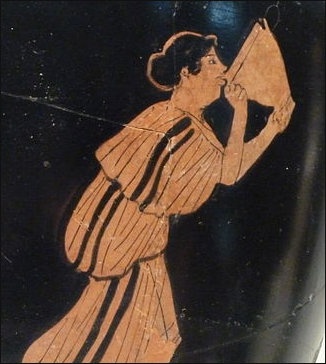
image from a vase of a woman drinking
The only drinks that were available to the Greeks in antiquity were water, wine, milk, and fruit juice. The Greeks preferred to drink from small, shallow cups rather than large and deep ones. Chilled fruit juices, milk and honey were enjoyed in the time of Alexander the Great (4th century B.C.). Rites of passage included giving three-year-old children their first jug, from which they had their first taste of wine.
Wine was far and away the main alcoholic drink. It was consumed with meals and at parties, regarded as sources of good conversation and extolled in poems and songs. Grape juice became wine quickly because there was no refrigeration or preservatives in ancient times.
The Greeks drank a lot wine but associated drunkenness with overindulgence and lack of discipline. According to their custom the Greeks mixed five parts water and two parts wine and sometimes added honey and salt water as flavoring. The Greeks believed that drinking undiluted wine could cause blindness, insanity or other terrible things. Later the Franks popularized the custom of drinking wine straight.
For hangover remedy, the forth century B.C. poet Amphis recommended boiled cabbage. An Ancient Greek spell for being able to drink a lot and not get drunk was to “eat a baked Pig's Lung.” [Papyri Graecae Magicae VII.181] |+|
Men used to hang out at wine shops where strong syrupy wine was poured from an amphorae and diluted with water in a large mixing bowl. Rich Greeks and Romans chilled their wine with snow kept in straw lined pits, even though Hippocrates thought that "drinking out of ice" was unhealthy.
The wine from Kos was good and relatively inexpensive. Higher quality wines came from Rhodes. Artemidorus described a drink called “ melogion” which "is more intoxicating than wine" and "made by first boiling some honey with water and then adding a bit of herb." Homer described a drink made from wine, barley meal, honey and goat cheese.
“Kottoabis” is one of the world first known drinking games, A fixture of all-night parties and reportedly even played by Socrates, the game involved flinging the dregs left over from a cup of wine at a target. Usually the participants sat in a circle and tossed their dregs at the basin in the center.
Websites on Ancient Greece: Internet Ancient History Sourcebook: Greece sourcebooks.fordham.edu ; Internet Ancient History Sourcebook: Hellenistic World sourcebooks.fordham.edu ; BBC Ancient Greeks bbc.co.uk/history/; Canadian Museum of History historymuseum.ca; Perseus Project - Tufts University; perseus.tufts.edu ; ; Gutenberg.org gutenberg.org; British Museum ancientgreece.co.uk; Illustrated Greek History, Dr. Janice Siegel, Department of Classics, Hampden–Sydney College, Virginia hsc.edu/drjclassics ; The Greeks: Crucible of Civilization pbs.org/empires/thegreeks ; Oxford Classical Art Research Center: The Beazley Archive beazley.ox.ac.uk ; Ancient-Greek.org ancientgreece.com; Metropolitan Museum of Art metmuseum.org/about-the-met/curatorial-departments/greek-and-roman-art; The Ancient City of Athens stoa.org/athens; The Internet Classics Archive kchanson.com ; Cambridge Classics External Gateway to Humanities Resources web.archive.org/web; Ancient Greek Sites on the Web from Medea showgate.com/medea ; Greek History Course from Reed web.archive.org; Classics FAQ MIT rtfm.mit.edu; 11th Brittanica: History of Ancient Greece sourcebooks.fordham.edu ;Internet Encyclopedia of Philosophy iep.utm.edu;Stanford Encyclopedia of Philosophy plato.stanford.edu
See Separate Article:
ORIGIN OF ALCOHOLIC DRINKS factsanddetails.com ;
EARLIEST WINES, WINEMAKING, WINERIES AND WINE GRAPES factsanddetails.com ;
EARLIEST BEER factsanddetails.com ;
DRINKS IN MESOPOTAMIA: MAINLY BEER africame.factsanddetails.com ;
ANCIENT EGYPTIAN DRINKS: BEER, WINE, MILK AND WATER africame.factsanddetails.com ;
WINE, DRINKS AND DRUGS IN ANCIENT ROME europe.factsanddetails.com
Wine in Ancient Greece
In the “Odyssey,” Homer wrote: "and a herald, going back and forth, poured the wine for them" and "grape cluster after grape cluster" (Lattimore 1965:143, 121). Wine is mentioned over ten times in The Odyssey, mostly in relation to feasts or religious ceremonies of some sort. In these ceremonies, the men drank wine in moderation and only when mixed and consumed with the food [Source: Matthew Maher, University of Western Ontario, The Odyssey of Ancient Greek Diet, Totem: The University of Western Ontario Journal of Anthropology, Volume 10, Issue 1, Article 3, June 19, 2011]

8th century Corinthian skyphos (wine-drinking cup)
Matthew Maher of the University of Western Ontario wrote: “Excavations on the island of Crete have provided archaeologists with many clues regarding the making, storage, and consumption of wine. There they have found residues in jars that indicate that they had once contained liquids, most likely olive oil or wine. On the mainland in the ancient city of Tiryns, the only physical remains of food discovered have been grape seeds. Because of the large quantity of seeds, it is assumed that they were used in the production of wine (Vickery 1936). Further evidence of the use of grapes in making wine is furnished by a discovery made by British archaeologists near Sparta, where they found a seal from the mouth of a jar. The clay imprints clearly show that it had been covered with leaves that have been identified as grape leaves (Vickery 1936). Although this doesn't prove the presence of wine, the evidence of grape leaves in this context certainly allows for that possibility.
“Another place to look for evidence of the presence of wine is pottery. Sometimes the shape of a pottery vessel can indictate its function. For example, the rhyton is a ritual pouring vessel that sometimes appeared in the shape of an animal head and is believed to have been used to pour wine (Pedley 1993). There are numerous examples of these types of vessels; specifically, a rhyton in the shape of a bull's head from Crete and one showing a hilltop sanctuary from the city of Zakro (Pedley 1993).
Evidence 6,200-Year-Old Wine Found In Greece: Oldest In Europe
In 2013, researchers working at the Dikili Tash site, two kilometers from the ancient city of Philippi an announced that chemical analysis of residues found on ceramics showed evidence of wine dating back to 4200 B.C.. The site has been inhabited since 6500 B.C., according to the researchers’ website. Dimitra Malamidou, a co-director of the excavation, told The Huffington Post, “All [that] is left from the liquid part is the residue in the surface of the ceramic vases,” she said. “Recent residue analysis on ceramics attested [to] the presence of tartaric acid, indicating fermentation.”[Source: Meredith Bennett Smith, Huffington Post, October 3, 2013 +++]
Meredith Bennett Smith wrote in Huffington Post: “Malamidou is part of a joint Greek-French excavation that began in 2008. The team recently wrapped up excavation of a neolithic house from around 4500 B.C. This is where they found wine traces in the form of “some thousands of carbonized grape pips together with the skins indicating grape pressing,” Malamidou said. Radiocarbon dating was used to pinpoint the age of the finds. +++
“Dikili Tash researchers believe they have found the oldest known traces of wine in Europe. Previous studies have unearthed a 6,100-year-old Armenian winery, as well as traces of a 9,000-year-old Chinese alcohol made from rice, honey and fruit. “The find is highly significant for the European prehistory, because it is for the moment the oldest indication for vinification in Europe,” Malamidou said. “The historical meaning of our discovery is important for the Aegean and the European prehistory, as it gives evidence of early developments of the agricultural and diet practices, affecting social processes.”“ +++
Wine Introduced to France by Ancient Greeks, Cambridge Study Says
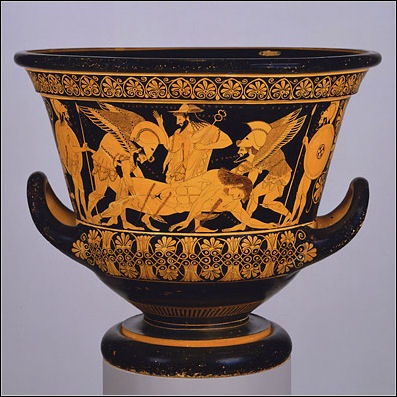
krater, used for mixing water with wine
A study by Prof Paul Cartledge of Cambridge University suggests that wine was introduced to France by a “band of pioneering Greek explorers” who settled in southern France around 600 B.C. The study debunks theories that the Romans brought viticulture to France. The study suggests the introduction took place at Massalia, present-day Marseilles, which the Greeks founded and turned into a trading site, where they traded with local tribes such as the Ligurian Celts. [Source: Andrew Hough, Telegraph.co.uk, October 23, 2009 -]
Andrew Hough wrote in the Telegraph: “Prof Cartledge said within a matter of generations the nearby Rhône became a major thoroughfare for vessels carrying terracotta amphorae that contained what was seen as a new, exotic Greek drink made from fermented grape juice. He argued the new drink rapidly became a hit among the tribes of Western Europe, which then contributed to the French’s modern love of wine. “I hope this will lay to rest an enduring debate about the historic origins of supermarket plonk,” he said. -
“Although some academics agree the Greeks were central to founding Europe’s wine trade, others argue the Etruscans or even the later Romans were the ones responsible for bringing viticulture to France.” Archaeologists have discovered a five-foot high, 31.5 stone bronze vessel, the Vix Krater, which was found in the grave of a Celtic princess in northern Burgundy, France. -
“Prof Cartledge said there were two main points that proved it was the Greeks who introduced wine to the region. First, the Greeks had to marry and mix with the local Ligurians to ensure that Massalia survived, suggesting that they also swapped goods and ideas. Second, they left behind copious amounts of archaeological evidence of their wine trade (unlike the Etruscans and long before the Romans), much of which has been found on Celtic sites.” The research forms part of Professor Cartledge’s study into where the boundaries of Ancient Greece began and ended. Rather than covering the geographical area occupied by the modern Greek state, he argued Ancient Greece stretched from Georgia in the east to Spain in the west.” -
Early Wine
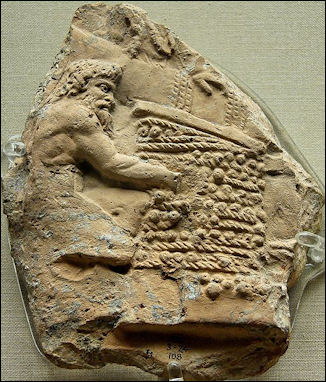
Greek satyr's wine press Intentional wine-making is believed to have begun in the Neolithic period (from about 9500 to 6000 B.C.) when communities settled in year-round settlements and began intentionally crushing and fermenting grapes and tending a grape crop year round. This is believed to have first occurred in Transcaucasus, eastern Turkey or northwestern Iran. Around the same time the Chinese were making wines with rice and local plant food.
Grapes contains a lot of sugar. Fermentation caused by the addition of yeast turns toe sugar into alcohol. Yeats is very common, Wild grapes often have some present on their skins, probably transported by wasps or other flying insects. Without distillation, the highest alcohol content is 5 percent for beer and 11 to 12 percent for wine. Above these levels the yeasts lo longer produce fermentation.
Stone Age people drank fermented wine by accident and probably made by accident too. The first people who drank alcohol probably eaten a fruit that fell off a tree and naturally fermented. Elephants sometimes get loaded by eating fermented fruit. Grapes sometimes ferment right on the vine. Birds who have gotten so drunk from eating sch grapes they have fallen off their perches.
Wine is believed to have been tasted by Paleolithic men who ate grapes with juice that had fermented within the grape skins during years that occurs naturally on the skins. They then might have made wine in containers that had to be drunk quickly, like Beaujolais Nouveau, before it turned to wine.
See Separate Articles FIRST WINES, WINERIES AND ALCOHOLIC DRINKS factsanddetails.com ; EARLIEST BEER factsanddetails.com
Wine Drinking Reflected in Ancient Greek Art and Crafts
There are numerous amphora reliefs showing the consumption of wine. A black-figure amphora from Attica, dated to approximately 500 B.C., shows Dionysus, the god of wine, consuming his drink from a large cup.
An amusing 2,400-year-old mosaic discovered in southern Turkey, discovered in 2012, depicts a skeleton reclining with a pitcher of wine and loaf of bread alongside Greek text that reads, "Be cheerful, enjoy your life." Archaeologist Demet Kara told Daily Sabah that the mosaic was located in the dining room of an upper class house from the 3rd century B.C. While a similar mosaics has been seen in Italy, the cheerful skeleton is the first of its kind to have been found in Turkey.,[Source: Jeva Lange , The Week, April 23, 2016]
After the turn of the 6th century B.C., changes in drinking cups correlated with Athens’ rising political power and rising dominance in the ceramic market. There was great variety and black-figured pottery production during this period. Stemmed cups were probably because they were easier to hold while reclining. The middle of the 6th century B.C. saw a rapid proliferation of cup types: Komast cups, Siana cups, Gordion cups, Lip cups, Band cups, Droop cups, Merry-thought cups and Cassel cups. Some were popular for only a few decades. During period of the devastating Persian Wars, the proliferation of cup types declined, with red-figured drinking cups, being introduced around 525 B.C., and quickly becoming the most popular. [Source: sciencedaily.com, January 2011]
Red-figured cups (cups decorated with red figures vs. black) were popular in the High Classical Period (480-400 B.C.), with the cups growing taller and shallower over time. During period of the Peloponnesian Wars and plague, drinking cup fashions came and went with lasting very long. , but few developed into long-lived styles. Terra-cotta “designer knock-offs” — plain, black clay cups with shiny surfaces and delicate stamped and incised designs — of “high-end” silver cups were common. During the Late Classical Period (400-323 B.C.) designer knock-off drinking cups continued; however, the variety of these “silver-inspired” clay cup designs declined with impractical designs like high-swung handles that served no useful purpose in clay falling out of fashion. The same was true with the tradition of decorating cups with human figures. A decorative innovation, called West Slope, became popular at this time. It consisted of colored clay applied atop black-glazed surfaces to create the effects of garlands and wreaths.
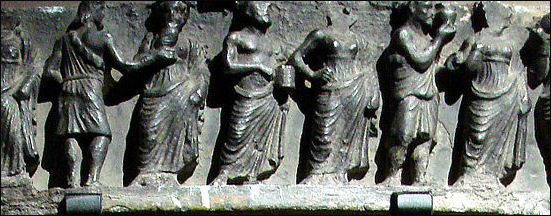
Hellenistic drinking scene
Symposiums and Ancient Greek Drinking Customs
A symposium was a dinner party with family, friends or associates. It generally began with a bout of drinking, followed by a big meal. There were often rules to ensure equality. Men participating in symposia, generally drank the same amount of wine mixed with water, served in rounds, as they reclined on couches or mattresses set in a circle or square. Conversation topics included philosophy, politics, gossip. For a short period Greeks used birthday cakes.
The word symposia was used to describe the party and the place were it was held and is the source of the modern word symposium. The parties were usually lead by a feast master. Sometimes the guests wore garlands. Some people drank heavily; others held back.
There are vivid description of party entertainment in Xenophon's dialogue Symposium (380 B.C.). The host pays a man from Syracuse to bring traveling performers (probably slaves), a girl flutists, acrobats, a dancing girl and a boy who dances and plays the kithara , a kind of lyre. The group played music and did performances involving music, dance, acrobatics and mine. The girl juggled hoops, performed acrobatic stunts over a hoop rimmed with knives, and acted out mythical love scenes with the boy. Socrates, one of the guests, was quite taken with the boy. The citizens of Sybaris in present-day southern Italy were such big partiers they reportedly banned roosters so the populous would not be woken to early in the morning. They also supposedly had wine piped directly from the vineyards to the city.
According to sciencedaily.com: “Think of these symposia as the ancient world’s ultimate cocktail parties, with established rituals and rules. An important aspect of any symposium was the wine cup, and the form of and the imagery on the cups reflected the shared culture of participants, as well as the larger social realities and changes in their world [Source: sciencedaily.com, January 2011 |+|]
“Basic rules of Athenian symposia:1) Couches or mattresses used by reclining participants were set in a circle or square. So, there was no formal position of status or group “head.” 2) Drinkers imbibed in rounds, so consumption of wine (mixed with water) was equitable. In other words, everyone got drunk at about the same rate. No teetotalers permitted. Kathleen Lynch, an associate professor of classics at the University of Cincinnati, told a meeting of the Archaeological Institute of America, “The focus was on drinking communally and in equal amounts. Inhibitions were lost. In-group bonds were formed. “|+|
“During the Iron Age (1,100-700 B.C.), symposia were reserved for the elite, probably allowing political factions to consolidate power and set themselves apart from the population at large. In other words, the drinking gatherings were for the “in” crowd. At this time, even grave markers for the very wealthy came in the form of the mixing bowls (kraters) used to blend wine with water during symposia. In other words, the ability to sponsor these drinking events was what people wanted to be remembered for.” |+|
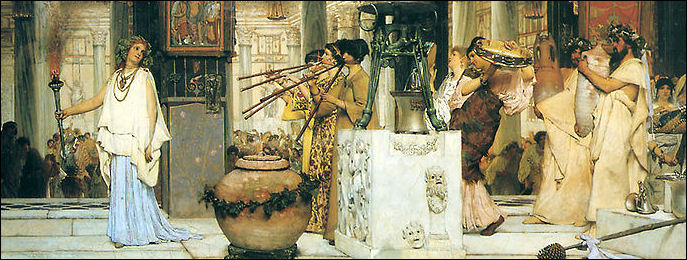
19th century vision of a Greek wine festival
“During Late Archaic Period (525-480 B.C.): “It is estimated that drinking vessels for symposia comprised up to 60 percent of the terra cotta fineware (collection of dishes) in the typical Athenian home. “The typical home had few useful dishes for eating in contrast to many vessels designed for drinking wine in communal settings,” explained Lynch. Finally, as Athens fell under the sway of Philip of Macedon and his son, Alexander the Great, the symposium came full circle. It began in the Iron Age as a practice of the elite. Then, with the movement toward democratization in Athens, participation in symposia broadened. Now, in Athens’ Hellenistic period, the practice was again the prerogative of the elites as a luxury and display of ostentatious consumption. Equality was no longer important in a state that was no longer democratic but monarchical.” |+|
Wine Cups Show Changes In Ancient Greek Drinking Habits
Wine cups used during social gatherings, called symposia, reflect changes in ancient Greek drinking habits according to Lynch, the University of Cincinnati professor. “In the same way that the coffee mug with ‘World’s Greatest Golfer’ in your kitchen cabinet speaks to your values and your culture, so, too, do the commonly used objects of the past tell us about that past,” she said. [Source: Wynne Perry, Lives Science, January 2011 /*/]
Wynne Perry of Lives Science wrote: “As the social context went full circle from elite party to common practice and back again, the appearance of the cups evolved as well, from simple and stemless to a profusion of styles to knockoffs that imitated the appearance of silverwork. During the Iron Age, from 1,100 to 700 B.C., the symposia were reserved for the elite, and grave markers for the very wealthy were even made to resemble the mixing bowls used to blend wine and water during the symposia. People wanted to be remembered by their ability to throw these events, according to Lynch.
“In the latter part of the late Archaic Period, from 525 to 480 B.C., the number of drinking cups increased, indicating the democratization of the cocktail parties, a phenomenon also occurring in the political and social arenas. In fact, these cups for communal drinking outnumbered regular dishes in the typical home. Lynch said, “Possessing what was newest in terms of mode and style of drinking cups was likely equated with knowledge and status. The elites may have been seeking cohesion and self definition in the face of factional rivalries and populist movements. This hypothesis underscores how the drinking symposia — and specific cup forms identified with specific factions — might have been used by aristocratic blocs to cement group bonds in the politically charged environment of the time.” [Source: sciencedaily.com, January 2011]
“During the High Classical Period from 480 to 400 B.C., the evolution in design continued, with red-figured cups remaining popular at first, but becoming taller and shallower. As Athenians weathered the Peloponnesian Wars and the plague, they sought escape, and drinking-cup fashions came and went. However, they tended to imitate silverwork: For example, plain, black clay cups with shiny surfaces became more common. Essentially, the common terra cotta cups were “designer knockoffs,” according to Lynch.
“This knockoff trend continued into the Late Classical Period, from 400 to 323 B.C., and garland and wreathlike designs replaced human forms as decoration. Athenian democracy disappeared, and by the end of this period, the practice of the symposia had returned to the elites. Equality was no longer important in a state that was now a monarchy, according to Lynch.” /*/
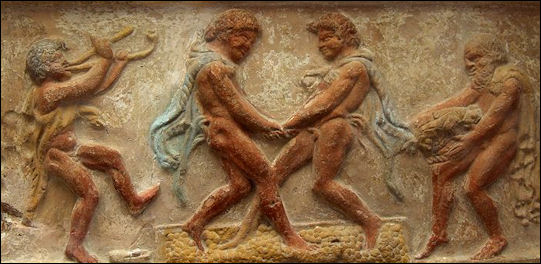
grape crushing
Kottabos, an Ancient Greek Drinking Game
Kottabos was a drinking game played at ancient Greek symposiums. Heather Sharpe, an associate professor of art history at West Chester University of Pennsylvania, has studied the game and even attempted to replicate it with her students. Megan Gannon wrote in Live Science, “At Greek symposia, elite men, young and old, reclined on cushioned couches that lined the walls of the andron, the men’s quarters of a household. They had lively conversations and recited poetry. They were entertained by dancers, flute girls and courtesans. They got drunk on wine, and in the name of competition, they hurled their dregs at a target in the center of the room to win prizes like eggs, pastries and sexual favors. Slaves cleaned up the mess. [Source: Megan Gannon, Live Science, January 14, 2015]
“Ancient texts and works of art indicate that there were two ways to play kottabos. In one variation, the goal was to knock down a disc that was carefully balanced atop a tall metal stand in the middle of the room. In the other variation, there was no metal stand; rather, the goal was to sink small dishes floating in a larger bowl of water. In both versions, participants attempted to hit their target with the leftover wine at the bottom of their kylix, the ancient equivalent of a Solo cup.
“The red-and-black kylixes had two looped handles and a shallow but wide body — a shape that perhaps was not the most practical for drinking but lent itself to playful decoration. Big eyes were sometimes painted on the underside on kylixes so that the drinker would look like he was wearing a mask when he took a hefty sip. And the relatively flat, circular inside of the cup, called the tondo, often carried droll or risqué pictures that would be slowly revealed as the wine disappeared. The tondo of one kylix at the Museum of Fine Arts in Boston bears the image of a man wiping his bottom. Another drinking cup at the same museum shows a man penetrating a woman from behind with the caption “Hold still.”
“Other paintings on kylixes were quite self-referential, with scenes of revelers playing kottabos. Based on those ancient illustrations, Sharpe had assumed that to play the game, you would swirl the dregs in the kylix and flick them at the target, almost as if you were doing a forehand throw with a Frisbee. But her experiment showed that that was not the most winning technique.
“To achieve the best results in kottabos, the participants had to loop a finger through one handle of the kylix and toss the juice overhand, as if they were pitching a baseball. Sharpe said that playing the game proved to be challenging, but she was amazed that some of her students started to hit the target within 10 to 15 minutes. “It took a fair amount of control to actually direct the wine dregs, and interestingly enough, some of the women were the first to get it,” Sharpe told Live Science. “In some respects, they relied a little bit more on finesse, whereas some of the guys were trying to throw it too hard.”
“Elite Greek women wouldn’t have taken part in symposia, but there are some indications that the courtesans, called hetairai, would have played kottabos with the men. “Another thing we quickly realized is, it must have gotten pretty messy,” Sharpe said. “By the end of our experiment we had diluted grape juice all over the floor. In a typical symposium setting, in an andron, you would have had couches arranged on almost all four sides of the room, and if you missed the target, you were likely to splatter your fellow symposiast across the way. You’d imagine that, by the end of the symposium, you’d be drenched in wine, and your fellow symposiasts would be drenched in wine, too.”“

symposia
Image Sources: Wikimedia Commons, The Louvre, The British Museum
Text Sources: Internet Ancient History Sourcebook: Greece sourcebooks.fordham.edu ; Internet Ancient History Sourcebook: Hellenistic World sourcebooks.fordham.edu ; BBC Ancient Greeks bbc.co.uk/history/ ; Canadian Museum of History historymuseum.ca ; Perseus Project - Tufts University; perseus.tufts.edu ; MIT, Online Library of Liberty, oll.libertyfund.org ; Gutenberg.org gutenberg.org Metropolitan Museum of Art, National Geographic, Smithsonian magazine, New York Times, Washington Post, Los Angeles Times, Live Science, Discover magazine, Times of London, Natural History magazine, Archaeology magazine, The New Yorker, Encyclopædia Britannica, "The Discoverers" [∞] and "The Creators" [μ]" by Daniel Boorstin. "Greek and Roman Life" by Ian Jenkins from the British Museum.Time, Newsweek, Wikipedia, Reuters, Associated Press, The Guardian, AFP, Lonely Planet Guides, “World Religions” edited by Geoffrey Parrinder (Facts on File Publications, New York); “History of Warfare” by John Keegan (Vintage Books); “History of Art” by H.W. Janson Prentice Hall, Englewood Cliffs, N.J.), Compton’s Encyclopedia and various books and other publications.
Last updated October 2018
